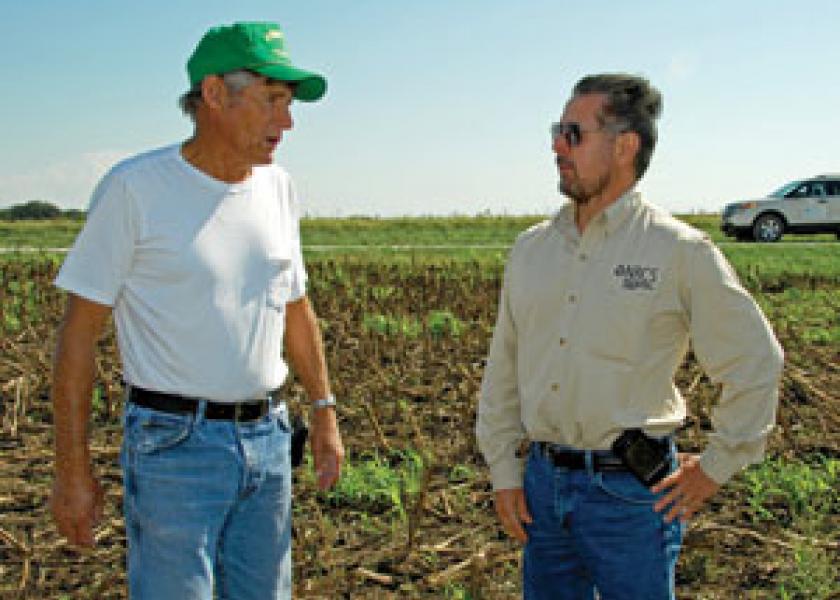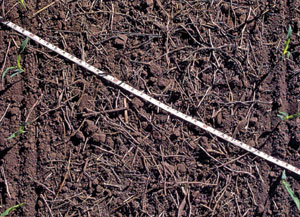Using Crop Residue to Reduce Erosion

A few simple measurements can help determine residue cover to reduce erosion and build organic matter
Splat. Splat-splat! Insect meets windshield is an exercise in violent physics. The same could be said of raindrops hitting unprotected soil. Unfortunately, soil particles aren’t durable like a glass
windshield and with raindrops intercepting bare soil at speeds of up to 20 mph, the damage can be immediate and long-term.
What’s at stake is the loss of organic matter, active soil microbes and soil structure. Fortunately, by using crop residue you can reduce erosion potential, increase water storage capacity and, with tillage and rotation tweaking, create a nitrogen credit for future crops by building organic matter.
No-till and strip-till farmer Nick Viney knows the value of evenly spreading residue behind the combine.
"We have large amounts of residue," says Viney, who farms near Edgerton in south-central Wisconsin. "With 200 bu. or better corn and 65 bu. or better soybeans, it is imperative that
residue has been evenly distributed throughout the field following harvest." Though he doesn’t measure residue cover, Viney says there’s very little soil visible on his no-till fields.
Terry Hill, a district conservationist with the Natural Resources Conservation Service (NRCS) in central Missouri, says residue cover is not easy to accurately estimate visually.
"We usually find that farmers overestimate what they have. What they think is 50% usually turns out to be 20% or 30%," he adds.
 |
The line-transect method can be used to measure |
The amount of residue necessary to protect the soil is typically more than farmers realize. This year’s drought complicates matters since there’s less residue than normal.
Tillage plays a role in protecting valuable topsoil. When running a chisel plow, disk or vertical tillage tool following harvest to chop stalks and root balls, keep in mind that every tillage pass
decreases the amount of residue. According to Hill, the trick is to shred tough Bt cornstalks without burying too much residue. Otherwise, there’s nothing to protect the soil through planting season next spring.
For those farmers who mulch-till in the fall, NRCS research shows a field needs 30% residue spread uniformly to have enough to overwinter and last through next year’s planting season.
Measure to manage. To check residue cover for compliance with cost-share programs, Hill and his staff use a linetransect method. Other methods, such as using photos at various residue percentage stages for field comparison or calculating tillage effects and weathering, can give a close approximation.
The line-transect method is typically used after spring planting. To get an idea of what you have before fall tillage and/or residue weathering, stretch a 100' tape diagonally at a 45° angle from the direction of the rows. Disregard end rows. Looking directly above the tape, count the number of times a 1' mark on the tape intersects a piece of residue. Count only on the left or right side of the tape to be consistent and avoid overcounting. Repeat the process five times to give a representation of the field. For example, if six pieces of residue intersected only six 1' marker lines on the left side of the 100' tape, this represents 60% residue. Take four more transects and average the percentages to get your residue percentage for the field.
The way forward. J.R. Flores, state NRCS conservationist in Missouri, says that moving from mulch-tillage systems to continuous no-till and adding cover crops might be the next step for many farmers to increase their residue cover. This transition requires practice and a long-term commitment.
"Farmers can begin seeing the soil health and productivity benefits after around five years of continuous no-till," Flores says. "In other cases, it may take up to 10 years."
In the meantime, he notes, soil health programs have been initiated in some Corn Belt states focusing on the use of more Environmental Quality Incentives Program dollars for residue practices. NRCS has announced a new National Soil Health and Sustainability effort that will provide more focus on funding residue management practices nationwide, he adds.
That’s good news for farmers such as Viney, who aerial seeds cover crops on two-thirds of his acres, which is an added upfront cost per acre. "We feel [incorporating cover crops] will stimulate additional biological activity in the soil and improve the speed at which residue breaks down," he says.
 |







